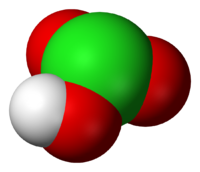- Chloric acid
-
Chloric acid 
 Other namesChloric(V) acid
Other namesChloric(V) acidIdentifiers CAS number 7790-93-4 ChemSpider 18513 Jmol-3D images Image 1 - O=Cl(=O)O
- InChI=1/ClHO3/c2-1(3)4/h(H,2,3,4)
Key: XTEGARKTQYYJKE-UHFFFAOYAG
Properties Molecular formula HClO3 Molar mass 84.45914 g mol−1 Appearance colourless solution Density 1 g/mL, solution (approximate) Solubility in water >40 g/100 ml (20 °C) Acidity (pKa) ca. −1 Structure Molecular shape pyramidal Hazards MSDS External MSDS Main hazards Oxidant, Corrosive Related compounds Other anions bromic acid
iodic acidOther cations ammonium chlorate
sodium chlorate
potassium chlorateRelated compounds hydrochloric acid
hypochlorous acid
chlorous acid
perchloric acidSupplementary data page Structure and
propertiesn, εr, etc. Thermodynamic
dataPhase behaviour
Solid, liquid, gasSpectral data UV, IR, NMR, MS Except where noted otherwise, data are given for materials in their standard state (at 25 °C, 100 kPa) Infobox references Chloric acid, HClO3, is an oxoacid of chlorine, and the formal precursor of chlorate salts. It is a strong acid (pKa ≈ −1) and oxidizing agent.
It is prepared by the reaction of sulfuric acid with barium chlorate, the insoluble barium sulfate being removed by precipitation:
- Ba(ClO3)2 + H2SO4 → 2HClO3 + BaSO4
Another method is the heating of hypochlorous acid, of which productions include chloric acid and hydrogen chloride:
- 3HClO → HClO3 + 2 HCl
It is also produced by the reaction of sulfuric acid with potassium chlorate in the combustion of sugar using potassium chlorate, sulfuric acid, and sugar.
It is stable in cold aqueous solution up to a concentration of approximately 30%, and solution of up to 40% can be prepared by careful evaporation under reduced pressure. Above these concentrations, and on warming, chloric acid solutions decompose to give a variety of products, for example:
- 8HClO3 → 4HClO4 + 2H2O + 2Cl2 + 3 O2
- 3HClO3 → HClO4 + H2O + 2 ClO2
The decomposition is controlled by kinetic factors: indeed, chloric acid is never thermodynamically stable with respect to disproportionation.
Chloric acid is a dangerously powerful oxidizing agent and will cause most organics and flammables to deflagrate on contact. For example a mixture of potassium chlorate and sugar will burn when concentrated sulfuric acid is added due to chloric acid production. Because sulfur tends to contain acidic impurities, it will form highly unstable mixtures with potassium chlorate due to chloric acid being produced.
Chloric Acid produced from the addition of concentrated sulfuric acid can decompose explosively producing a variety of products such as oxygen, chlorine, and chlorine oxides
See also
References
- Greenwood, Norman N.; Earnshaw, Alan (1997). Chemistry of the Elements (2nd ed.). Oxford: Butterworth-Heinemann. ISBN 0080379419.
- R. Bruce King, ed (1994). "Chloric acid". Encyclopedia of Inorganic Chemistry. 2. Chichester: Wiley. p. 658. ISBN 0-471-93620-0.
Hydrogen compounds H3AsO3 · H3AsO4 · HAt · HSO3F · HBF4 · HBr · HBrO · HBrO2 · HBrO3 · HBrO4 · HCl · HClO · HClO2 · HClO3 · HClO4 · HCN · HCNO · H2CrO4/H2Cr2O7 · H2CO3 · H2CS3 · HF · HFO · HI · HIO · HNC · HNCO · HNO · HNO3 · H2N2O2 · HNO5S · H3NSO3 · H2O · H2O2 · H2O3 · H3PO2 · H3PO3 · H3PO4 · H4P2O7 · H5P3O10 · H2PtCl6 · H2S · H2Se · H2SeO3 · H2SeO4 · H4SiO4 · H2SiF6 · H2SO3 · H2SO4 · H2SO5 · H2S2O3 · H2S2O6 · H2S2O7 · H2S2O8 · CF3SO3H · H2Te · H2TeO3 · H6TeO6 · H4TiO4 · H2Po · H3VO4 · HCo(CO)4
Categories:- Hydrogen compounds
- Chlorates
- Oxidizing agents
- Oxidizing acids
- Inorganic compound stubs
Wikimedia Foundation. 2010.
